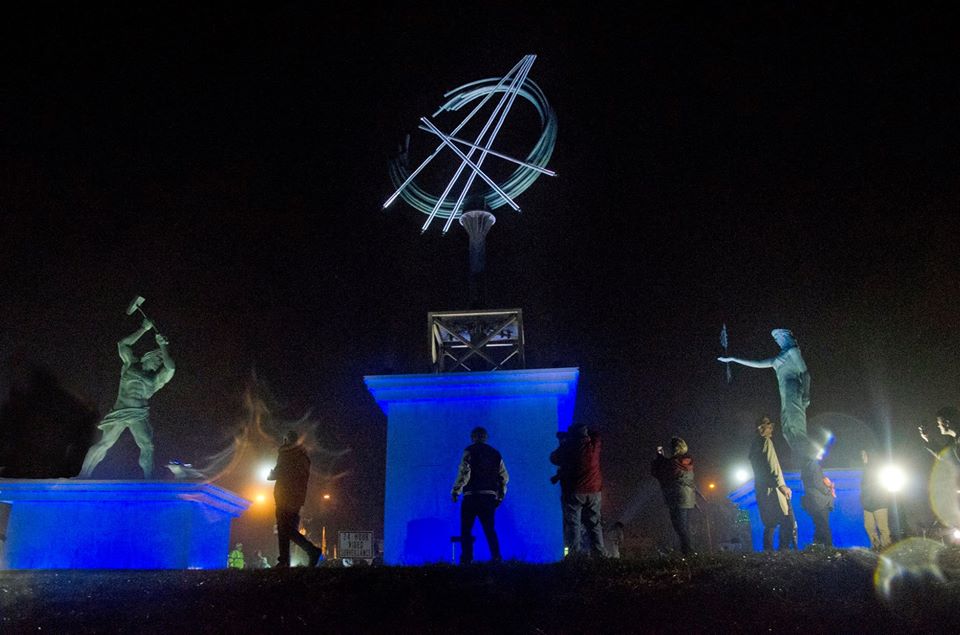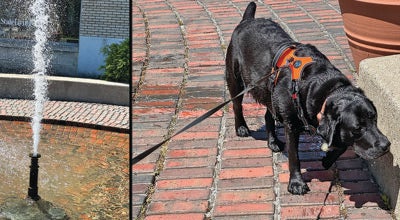A gift for the ages: Ashland dedicates new riverfront sculptures
Published 8:30 am Tuesday, January 7, 2020

- (The Tribune | Heath Harrison)
ASHLAND. Ky. — A large crowd turned out on the Ohio riverfront in Kentucky on Friday for the dedication and illumination of three new sculptures at the Port of Ashland.
The monumental works are a commission by New York-based artist Ginés Serrán-Pagán, who gave a presentation at the nearby Paramount Arts Center prior to the lighting.
Ashland Mayor Steve Gilmore, who said he was “speechless” when he first saw the towering works, said they came about as the result of an anonymous donor, who covered the cost of materials, installation and has provided for a maintenance fund. Serrán-Pagán created the pieces at no charge.
“The benefactor personally took care of expenses, which I can assure you were huge,” Gilmore said, adding he has known the individual for a long time. “He’s a native to Ashland and loves his hometown. This is a gift to our citizens. This isn’t costing the city anything.”
He said he does not know the exact figure of the cost paid by the donor, who introduced him to Serrán-Pagán, but estimates it to be well over $1 million.
Serrán-Pagán, who was born in Spain, has had more than 250 exhibitions in 20 countries and is world renowned for his paintings and sculptures. He is one of the few artists producing monumental bronze sculptures today and his works include “Calypso,” “The Columns of Hercules,” and “The Union of the World,” a 100-foot tall statue of Christ in the Philippines, where his 23-meter-tall work, “The Emperador,” is also on display.
Gilmore, who is beginning his final year as Ashland mayor before retiring, said the project began when Serrán-Pagán visited Ashland.
“I was impressed with the energy of the region and he went to the riverfront,” Serrán-Pagán said. “I loved the landscape.”
Serrán-Pagán said he visited Paul Blazer High School and became interested in a symbol used in an old yearbook and on the building, which he recognized as based on the work of Renaissance artists. It served as the basis for “Genesis,” the tallest and centerpiece of the three pieces.
He said the abstract design honors the faith and church community in the city and that the four rods in the piece, which resemble an “A” in a near-circle, represents five elements.
“The first four are water, air, earth and fire,” Serrán-Pagán said. “With the fifth being God — meaning that from these five elements you get life.”
The piece is motorized and rotates 360 degrees on its axis 24 hours a day, with the rods illuminated in various colors.
Flanking “Genesis” on each side are two figural sculptures, from which Serrán-Pagán drew from the symbolism of Roman mythology.
The “Vulcan of Ashland” shows the god of fire, known as Hephaestus in Greek mythology, hammering the five elements on a forge.
Serrán-Pagán said the work is meant to symbolize the city’s history of metal and steel and “the strength of the hard working people who live here.”
On the opposite side of “Genesis” is the “Venus of Ashland,” depicting Vulcan’s wife, known as Aphrodite in Greek myths. The goddess of love and beauty, Serrán-Pagán said she represents “the love of the wonderful people, culture and natural beauty of the City of Ashland and the Commonwealth of Kentucky.”
In her hand she holds an ash tree, the city’s namesake, with the roots descending from her hand, which symbolizes care for the environment.
Serrán-Pagán said the works took about 15 months to complete, beginning with drawings he showed Gilmore and city leaders.
They went through three stages of production, with the first being the building of an armature of wood and iron, followed by clay added to make the figures.
Then, they were coated in fiberglass before being cast in bronze.
Serrán-Pagán said the casting took place in China, due to the higher quality of materials there, then they were shipped to Ashland in containers by sea and then brought by truck from Virginia. The journey took about a month.
Once they arrived, they were installed on their pedestals by a crew from McKenzie Concrete.
Standing more than 30 feet on her pedestals, “Venus of Ashland” is the largest female bronze classical sculpture in the world and, along with “Vulcan of Ashland,” one of the two tallest sculptures from classical mythology in the world.
Gilmore said the reaction has been positive, and hopes that having such a display, visible across the river from U.S. 52 in Ohio, from such an acclaimed artist will draw tourists to the city.
“We’re at the heart of a major travel network, if you look at a map,” he said, naming all of the major highways and Interstate 64. “People go through here a lot. Hopefully, they will see that and stop. And it can help to ignite the region’s art community.”
Gilmore said an informational plaque at the base of the sculptures will explain the meaning behind each to visitors. He said the works are also under 24-hour video surveillance to protect them from vandalism. The lighting, which is programmable for multiple sequences and colors, will run from dusk to dawn.
Serrán-Pagán said the feeling of what he is giving to the ages comes over him when he completes a work. He said works such as these are built to last for up to 5,000 years.
“Even if you threw them to the river,” he said. “This is historic. This is the first day of sculptures that could last thousands of years.”
He noted that that there are some bronze statues in museums that are more than 8,000 years old.
“You feel insignificant,” Serrán-Pagán said. “Life is ephemeral, but sculptures last. You’re leaving a legacy.”
He said it is “humbling” to create a work “from zero.”
“When you finish, it looks like they have life and a soul and can talk,” he said, adding the works now “belong to the people of Ashland.”
Gilmore said he was impressed by the modesty of Serrán-Pagán, who he said “fell in love with” the city on his first trip, while visiting a friend. He said the artist plans to stay in touch and return often.
“He’s so genuine,” Gilmore said. “He knew the great work ethic here. That’s what he represents. We’re proud and hope citizens appreciate what a gift this is to Ashland.




